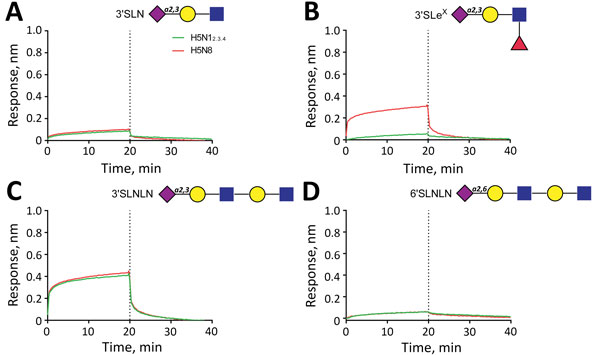Volume 23, Number 2—February 2017
Research
Highly Pathogenic Influenza A(H5Nx) Viruses with Altered H5 Receptor-Binding Specificity
Figure 4

Figure 4. Analysis of binding of influenza A virus H5N12.3.4 and H5N8 hemagglutinins to sialylated glycans by using biolayer interferometry. A) 3′SLN, B) 3′SLeX, C) 3′SLNLN, D) 6′SLNLN. After complexing biotinylated glycans with streptavidin sensors, association and subsequent dissociation of H5 proteins complexed with StrepMAB-classic (IBA GmbH, Göttingen, Germany) was determined. Blue squares, N-acetylglucosamine; yellow circles, galactose; purple diamonds, sialic acid; red triangles, fucose. The dotted lines at the 20-min time points distinguish the association and dissociation phases. H5N12.3.4, novel H5N1 virus clade 2.3.4.
1These authors contributed equally to this article.
Page created: January 17, 2017
Page updated: January 17, 2017
Page reviewed: January 17, 2017
The conclusions, findings, and opinions expressed by authors contributing to this journal do not necessarily reflect the official position of the U.S. Department of Health and Human Services, the Public Health Service, the Centers for Disease Control and Prevention, or the authors' affiliated institutions. Use of trade names is for identification only and does not imply endorsement by any of the groups named above.